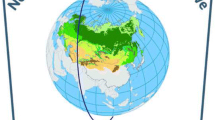Abstract.
Understanding the earth system requires that the two-way linkages between regions and the global system be well understood and predictable. Most studies of global change are undertaken thematically across limited disciplinary boundaries; few are attempted holistically across many disciplines within regions. The regional approach offers many advantages. Here a variety of linkages associated with the regions of Southern Africa, South Asia, East Asia and Southeast Asia are presented to illustrate the power of a regional approach to earth system science. Major findings include the extent to which long-range transport of aerosols and nutrients affect terrestrial and marine ecosystem functioning in and around southern Africa. Aerosol transport, and the development of a regional haze layer, over South Asia are shown to alter significantly the radiative forcing of change in the atmosphere over the region. Changes in land cover and use over East Asia over along period of time are shown to have affected the strength of the monsoon circulation significantly. Finally, rampant economic development and globalization in Southeast Asia are demonstrated to have been a significant driver of regional change.
Similar content being viewed by others
Author information
Authors and Affiliations
Additional information
Electronic Publication
Rights and permissions
About this article
Cite this article
Tyson, .P., Steffen, .W., Mitra, .A. et al. The earth system: regional–global linkages. Reg Environ Change 2, 128–140 (2001). https://doi.org/10.1007/s101130100033
Received:
Accepted:
Issue Date:
DOI: https://doi.org/10.1007/s101130100033




